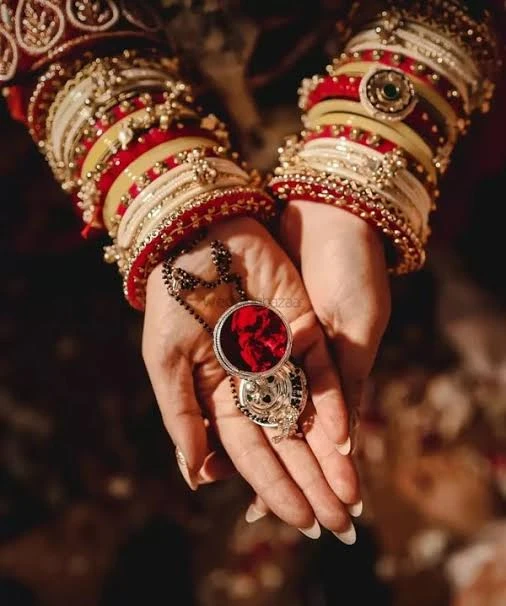
The Symbols Of Marriage: Sankha, Sindoor, Mangalsutra.
In Odia culture, the mangalsutra, sindoor, and sankha are not just traditional ornaments but profound symbols of marital commitment and cultural identity. Each of these elements holds a unique place in the wedding ceremonies and daily lives of married women, reflecting deep-rooted beliefs and practices. In this blog, we’ll explore the significance of these sacred symbols in Odia culture, their meanings, and how they continue to be cherished in contemporary times.
1. The Mangalsutra: A Symbol of Union
The mangalsutra, known as "Mangalasutra" or "Mangalya Sutra" in Odia, is a revered ornament that signifies the marital bond between husband and wife. Traditionally crafted with black beads and gold, the mangalsutra represents prosperity, protection, and a sacred connection.
a. Historical Significance:
The mangalsutra is believed to protect the husband from evil influences and ensure a long, prosperous married life. The black beads are said to ward off negative energies, while the gold symbolizes wealth and stability.
b. Ritualistic Role:
During the wedding ceremony, the groom ties the mangalsutra around the bride's neck, symbolizing the beginning of their marital journey. This ritual is a profound moment that signifies their commitment and the union of their souls.
c. Modern Adaptations:
Today’s mangalsutras come in various designs, from traditional to contemporary. While the classic black-and-gold version remains popular, many women opt for modern styles that incorporate diamonds or other precious stones, reflecting their personal taste while honouring tradition.
2. Sindoor: The Mark of Commitment
Sindoor, or vermillion powder, is another essential element in Odia marital traditions. It is applied to the parting of a married woman's hair and is considered a powerful symbol of her marital status and devotion.
a. Spiritual and Symbolic Meaning:
The act of applying sindoor is more than just a cosmetic practice; it represents the woman’s commitment to her husband and her role as a married woman. It is a visible mark of her dedication and the sacred bond she shares with her spouse.
b. Cultural Practices:
In Odia culture, the application of sindoor is often accompanied by rituals and blessings from elders. It is usually applied during significant occasions and ceremonies, reinforcing its role as a symbol of marital bliss and longevity.
c. Evolution and Modern Usage:
While the tradition of wearing sindoor continues, modern interpretations have introduced various shades and formulations. Despite these changes, the fundamental significance of sindoor as a symbol of marital commitment remains intact.
3. Sankha: The Symbol of Purity
The sankha (conch shell bangle) is a distinctive ornament worn by married Odia women. Traditionally made of conch shell and sometimes adorned with gold, the sankha is not just a fashion accessory but a symbol of purity, auspiciousness, and marital fidelity.
a. Cultural and Ritualistic Importance:
The sankha is traditionally worn on the left wrist, often paired with the patli (another type of bangle). It is believed to have protective and purifying qualities, signifying the woman’s commitment to her husband and her role in the family.
b. Symbolism:
The conch shell, from which the sankha is made, is considered sacred in Hindu culture. It is associated with the goddess Lakshmi and symbolizes purity and prosperity. Wearing the sankha is a way for married women to honour these qualities and maintain a sacred connection with their cultural heritage.
c. Modern Adaptations:
While traditional sankhas remain popular, contemporary designs and materials have also emerged. These modern versions often combine traditional aesthetics with contemporary fashion, allowing women to celebrate their heritage while expressing their personal style.
4. The Interconnectedness of Mangalsutra, Sindoor, and Sankha
In Odia culture, the mangalsutra, sindoor, and sankha are interconnected symbols that collectively represent the essence of marital life. They are worn together to signify a woman’s commitment, purity, and spiritual connection with her spouse.
a. Ritualistic Harmony:
The combination of these symbols during the wedding ceremony and in daily life reflects a harmonious blend of tradition and spirituality. Each element complements the others, reinforcing the significance of marital unity and devotion.
b. Cultural Continuity:
By wearing these traditional symbols, Odia women honour their cultural heritage and the values passed down through generations. Despite the changing times, these practices continue to hold a special place in the lives of married women, symbolizing their enduring connection to their roots.
Conclusion
The mangalsutra, sindoor, and sankha are more than mere accessories in Odia culture; they are deeply symbolic markers of marital commitment, purity, and cultural identity. Each of these elements carries its own unique significance, yet together they form a powerful representation of the sacred bond between husband and wife. As Odia culture continues to evolve, these traditions remain a cherished part of the marital experience, bridging the past with the present and honouring the rich heritage of the community.
By understanding and embracing the importance of these symbols, we not only preserve cultural traditions but also celebrate the enduring values that continue to shape our lives and relationships.

Related Posts